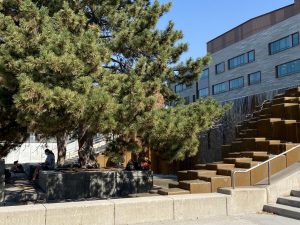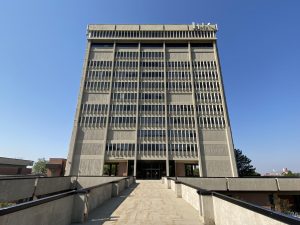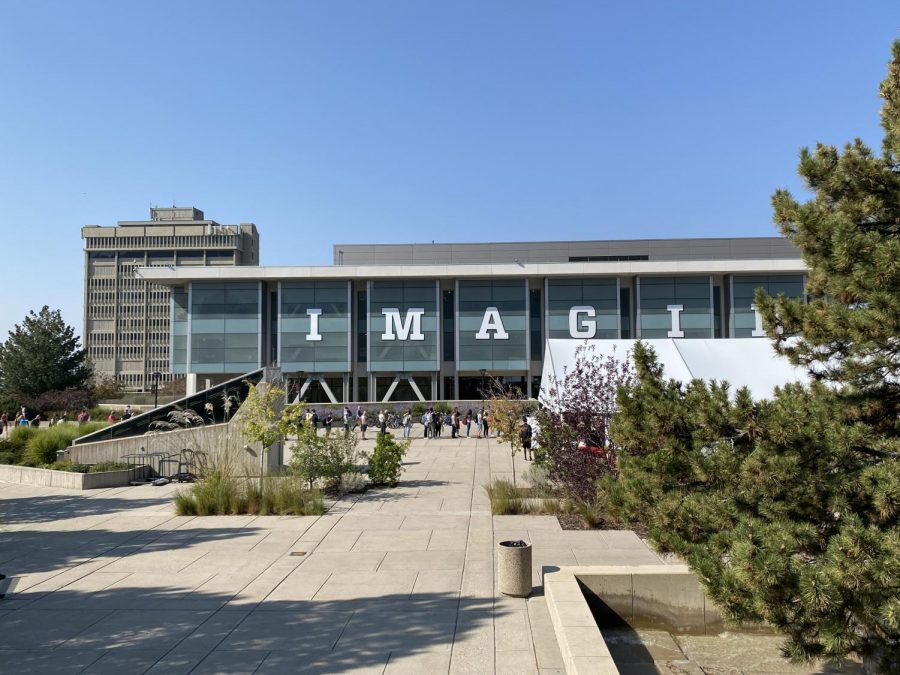Design and Mental Health – How Buildings on Campus can Help Students Thrive
University of Utah campus. (Photo by Paige Gardner | The Daily Utah Chronicle)
October 2, 2021
We shape our buildings; thereafter, they shape us.
— Winston Churchill
While it may be one of the only things Winston Churchill has said or done that I can agree with, I think this sentiment still rings true more than half a century later. Interior design and architecture are not just aesthetic tools for making buildings look appealing — good design fixes problems and can shape our built environment to be dynamic and comfortable.
What Makes a Building Good?
We’re inside most of our lives. How a space is designed really affects how we feel and how we behave.
— Ilse Crawford, Interior Designer
Good design can make life a lot easier, but can it actually have an impact on mental health? Environmental psychologists aimed to answer this question in 1953. The team studied various aspects of mental health institutions like light, color and private vs. public spaces. Their findings became the basis for the burgeoning field of environmental psychology.
Many in the field of environmental psychology today have suggested that making buildings sustainable and adaptable is an excellent place to start when designing buildings that promote mental wellness. Incorporating natural elements like plant life and bringing in plenty of natural light can help people feel more comfortable and balanced in a space.
Beyond that, interior design elements can help buildings function to better meet user needs.
How Do the U’s Buildings Measure Up?
To determine if the University of Utah’s buildings were promoting mental wellness, I decided to take the tour I never got during orientation (as a transfer student during the coronavirus pandemic) and explore the campus to see what spaces were best for students. In my self-guided tour, I explored a dozen or so buildings and talked to a few students about their favorite and least favorite places on campus.
In my search, I realized that designs to fit student needs seem to be a continuous challenge. Buildings, parking lots and other infrastructure are constantly under construction and change the landscape on a regular basis.
The types of construction projects that are prioritized on campus speak to the U’s focus on STEM and business programs — the social sciences and arts buildings are for the most part dated, and, to be honest, sometimes drab. However, the newness or antiquity of buildings didn’t seem to be the driving factor affecting student opinion.
The Good

I got mixed results talking to students about their favorite buildings on campus — some are die-hard fans of Gardner Commons or the Marriott Library, others love the Student Union.
The Law School blows everything else out of the water.
— Anna Paseman, Second Year Law Student
The Law Building was certainly a crowd favorite, and venturing inside the building for the first time, it’s easy to see why. Big windows, ample study room and a clean, quiet atmosphere make it the perfect place to study.
It feels like it was built for people to enjoy.
— Lucy Schoenfeld, Linguistics Major
In close second, it seems the Art and Architecture Building has stolen many student’s hearts. Psych major Karen Bennett said, “The concrete is rather unwelcoming, yet, the color of the wood is so warm. And it’s full of art and artists!”
Other unsung heroes among the student favorites include the Crocker Science Center, the MHC Library, the the Sorenson Molecular Biotechnology Building and the Irish Humanities Building.
The Bad

I HATE THE SOC BUILDING SO MUCH.
— Leslie Sroczynski, Health Society and Policy and Sociology Major
Indisputably, the Social and Behavioral Science Building ranks dead-last in the opinions of students I spoke with, and I can’t really blame them. Commonly referred to as the “Tower of Terror,” the Soc. building stands alone (quite literally, as you have to walk across a bridge to get to the main elevator lobby) on the Southwest corner of campus. It’s Kafkaesque and, not to mention, spooky.
The Takeaway
“Lots of stairs, but I liked the big windows.”
— Chloe Koken, Special Education Major
In talking with students about their favorite and least favorite places on campus, I learned that big windows and space to study and meet with classmates go a long way. Conversely, inconvenience like lots of stairs and crowding make for some of the least-liked spaces.
Good design is not a panacea for mental illness or by any means a substitute for professional help or prescribed medication, but it is certainly a way to add comfort, connection and joy to our lives.
Buildings that are designed to let in light, incorporate natural elements and bring people together are good for mental well-being. Buildings on campus that have all of these features are well-loved and well-used.








